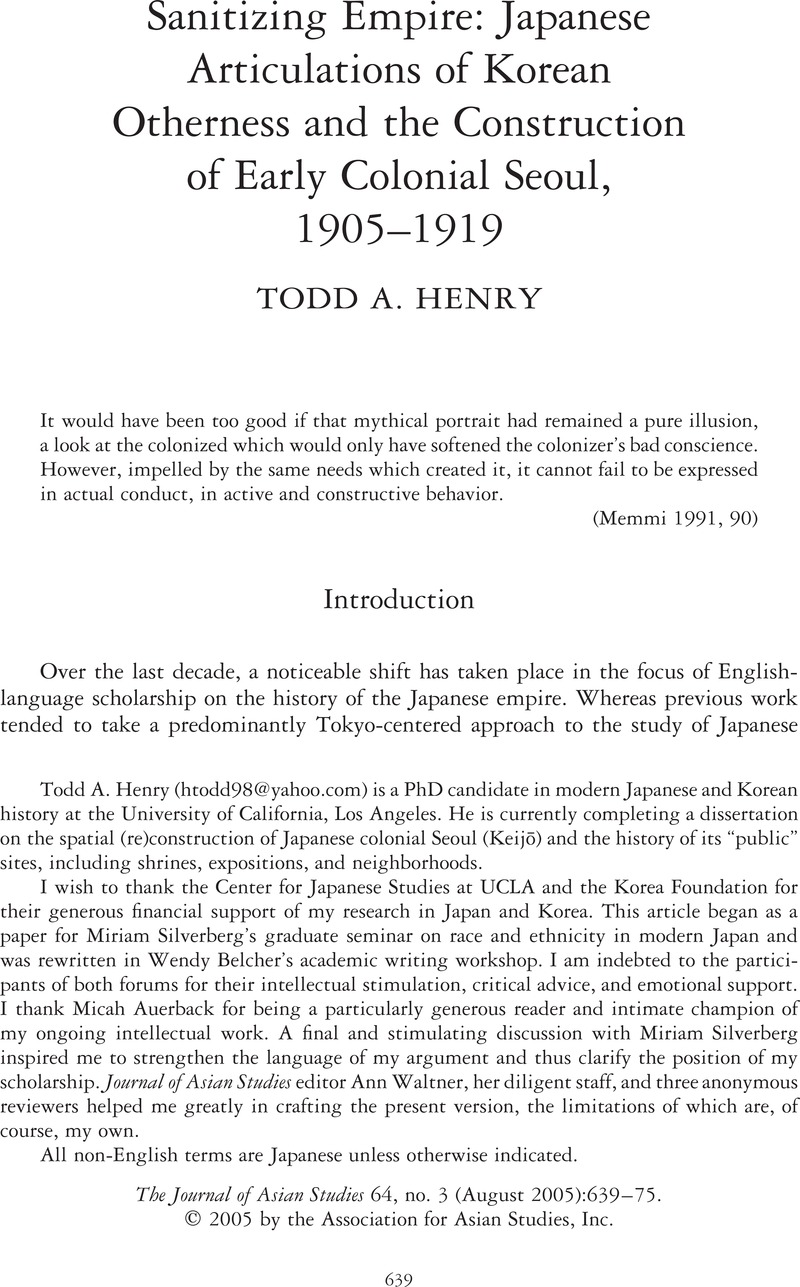Crossref Citations
This article has been cited by the following publications. This list is generated based on data provided by Crossref.
Fraser, Alistair
2010.
The Craft of Scalar Practices.
Environment and Planning A: Economy and Space,
Vol. 42,
Issue. 2,
p.
332.
Kono, Kimberly T.
2010.
Romance, Family, and Nation in Japanese Colonial Literature.
p.
1.
Kono, Kimberly T.
2010.
Romance, Family, and Nation in Japanese Colonial Literature.
p.
75.
Uchida, Jun
2011.
A Sentimental Journey: Mapping the Interior Frontier of Japanese Settlers in Colonial Korea.
The Journal of Asian Studies,
Vol. 70,
Issue. 3,
p.
706.
Barlow, Tani
2012.
DEBATES OVER COLONIAL MODERNITY IN EAST ASIA AND ANOTHER ALTERNATIVE.
Cultural Studies,
Vol. 26,
Issue. 5,
p.
617.
Watt, Lori
2015.
Embracing Defeat in Seoul: Rethinking Decolonization in Korea, 1945.
The Journal of Asian Studies,
Vol. 74,
Issue. 1,
p.
153.
Lee, Victoria
2015.
Unraveling the search for microbial control in twentieth-century pandemics.
Studies in History and Philosophy of Science Part C: Studies in History and Philosophy of Biological and Biomedical Sciences,
Vol. 53,
Issue. ,
p.
122.
Kim, Jae Kyun
2015.
Yellow over Black: History of Race in Korea and the New Study of Race and Empire.
Critical Sociology,
Vol. 41,
Issue. 2,
p.
205.
2016.
Duress.
p.
381.
Hanson, Marta
2016.
The Anthropology and History of Medicine in Korea.
Asian Medicine,
Vol. 11,
Issue. 1-2,
p.
1.
Kim, Jeong-Ran
2016.
Malaria and Colonialism in Korea,c.1876–c.1945.
Social History of Medicine,
Vol. 29,
Issue. 2,
p.
360.
Hanson, Marta
2017.
Visualizing the Geography of the Diseases of China: Western Disease Maps from Analytical Tools to Tools of Empire, Sovereignty, and Public Health Propaganda, 1878–1929.
Science in Context,
Vol. 30,
Issue. 3,
p.
219.
Taylor-Jones, Kate E.
2018.
Shopping, sex, and lies:Mimong/Sweet Dreams(1936) and the disruptive process of colonial girlhood.
Journal of Japanese and Korean Cinema,
Vol. 10,
Issue. 2,
p.
98.
Woo, Youngki
Maguire, Edward R.
and
Gau, Jacinta M.
2018.
Direct and indirect effects of procedural justice on cooperation and compliance: evidence from South Korea.
Police Practice and Research,
Vol. 19,
Issue. 2,
p.
168.
Choi, Ellie
2018.
Memories of Korean Modernity: Yi Kwangsu'sThe Heartlessand New Perspectives in Colonial Alterity.
The Journal of Asian Studies,
Vol. 77,
Issue. 3,
p.
659.
Low, Kelvin E. Y.
2018.
The International Encyclopedia of Anthropology.
p.
1.
Low, Kelvin E. Y.
2019.
Theorising Sensory Cultures in Asia: Sociohistorical Perspectives.
Asian Studies Review,
Vol. 43,
Issue. 4,
p.
618.
Toner, Simon
2019.
“The Paradise of the Latrine”: American Toilet-Building and the Continuities of Colonial and Postcolonial Development.
Modern American History,
Vol. 2,
Issue. 3,
p.
299.
Choung, Eun-hye
and
Choi, Suh-hee
2020.
Sorokdo as a combined dark tourism site of leprosy and colonized past.
Asia Pacific Journal of Tourism Research,
Vol. 25,
Issue. 8,
p.
814.
Shishova, Ekaterina S.
2020.
New Residential Districts Ordering: from Language of Smells Description to the Space Sensory Order.
Inter,
Vol. 12,
Issue. 3,
p.
10.



